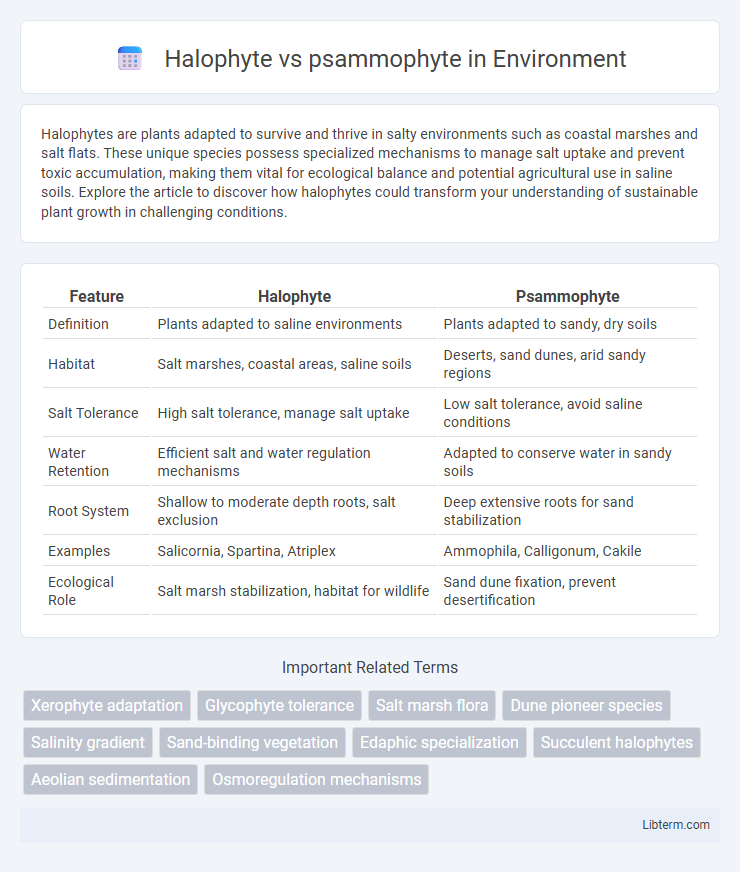Halophytes are plants adapted to survive and thrive in salty environments such as coastal marshes and salt flats. These unique species possess specialized mechanisms to manage salt uptake and prevent toxic accumulation, making them vital for ecological balance and potential agricultural use in saline soils. Explore the article to discover how halophytes could transform your understanding of sustainable plant growth in challenging conditions.
Table of Comparison
| Feature | Halophyte | Psammophyte |
|---|---|---|
| Definition | Plants adapted to saline environments | Plants adapted to sandy, dry soils |
| Habitat | Salt marshes, coastal areas, saline soils | Deserts, sand dunes, arid sandy regions |
| Salt Tolerance | High salt tolerance, manage salt uptake | Low salt tolerance, avoid saline conditions |
| Water Retention | Efficient salt and water regulation mechanisms | Adapted to conserve water in sandy soils |
| Root System | Shallow to moderate depth roots, salt exclusion | Deep extensive roots for sand stabilization |
| Examples | Salicornia, Spartina, Atriplex | Ammophila, Calligonum, Cakile |
| Ecological Role | Salt marsh stabilization, habitat for wildlife | Sand dune fixation, prevent desertification |
Introduction to Halophytes and Psammophytes
Halophytes are salt-tolerant plants that thrive in saline environments such as coastal marshes, salt flats, and saline deserts, displaying specialized adaptations for salt regulation and water retention. Psammophytes, on the other hand, are plants adapted to sandy soils and deserts where loose, nutrient-poor substrates require extensive root systems and drought resistance mechanisms. Both halophytes and psammophytes play crucial ecological roles in stabilizing soils and supporting biodiversity in extreme habitats.
Definition and Characteristics of Halophytes
Halophytes are salt-tolerant plants adapted to thrive in high-salinity environments such as salt marshes and coastal regions, whereas psammophytes specialize in growing in sandy soils with low nutrient availability. Halophytes exhibit unique physiological characteristics including salt excretion mechanisms, succulent leaves for water storage, and specialized root systems to manage salt uptake and osmotic balance. These adaptations enable halophytes to maintain cellular function despite osmotic stress and toxic ion concentrations typical of saline habitats.
Definition and Characteristics of Psammophytes
Psammophytes are specialized plants adapted to thrive in sandy environments, where low nutrient availability, high drainage, and shifting substrates are common. These plants exhibit deep root systems for anchorage and water absorption, tolerance to drought, and often have small, tough leaves to reduce water loss. In contrast, halophytes are salt-tolerant plants adapted to saline soils, focusing on salt exclusion or accumulation mechanisms rather than sandy soil adaptations.
Key Environmental Adaptations
Halophytes thrive in saline environments by using salt glands and osmotic regulation to manage salt stress and maintain cellular homeostasis. Psammophytes adapt to sandy, nutrient-poor soils through deep root systems and specialized water retention mechanisms to withstand drought and soil instability. Both plant types exhibit unique physiological and morphological traits enabling survival in extreme habitats characterized by salinity or shifting sands.
Soil and Habitat Preferences
Halophytes thrive in saline soils commonly found in coastal marshes, salt flats, and saline deserts, where salt concentration exceeds 200 mM NaCl, requiring specialized salt tolerance mechanisms. Psammophytes prefer sandy soils with low nutrient availability and excellent drainage, typically inhabiting dunes, sandy beaches, and arid sandy deserts prone to wind erosion. The contrasting soil preferences highlight halophytes' adaptation to high salinity and moisture retention, while psammophytes are adapted to dry, nutrient-poor, and well-aerated environments.
Physiological Mechanisms of Salt and Sand Tolerance
Halophytes exhibit specialized physiological mechanisms such as salt ion compartmentalization within vacuoles and efficient synthesis of osmoprotectants like proline to maintain cellular homeostasis under high salinity conditions. Psammophytes demonstrate adaptations including enhanced root water uptake and protective morphological features that mitigate abrasive sand damage and reduce water loss in sandy soils. Both plant types utilize antioxidant enzyme systems to counteract oxidative stress induced by their respective harsh environments, ensuring survival and growth.
Examples of Halophyte Species
Halophyte species thrive in saline environments and include plants like Salicornia europaea, Spartina alterniflora, and Atriplex halimus, which have specialized salt tolerance mechanisms. These species are often found in salt marshes, coastal lagoons, and saline deserts, contrasting with psammophytes that adapt to sandy, nutrient-poor soils rather than high salinity. Understanding the ecological roles of halophytes is crucial for saline soil reclamation and coastal habitat restoration.
Examples of Psammophyte Species
Psammophytes are specialized plants adapted to grow in sandy environments with low nutrient availability and high drought stress, commonly found in deserts and coastal dunes. Examples of psammophyte species include Ammophila arenaria (European beachgrass), Cakile maritima (sea rocket), and Panicum turgidum, all exhibiting adaptations such as deep root systems and waxy leaf coatings to stabilize sand and conserve water. These species contrast with halophytes, which thrive in saline habitats, emphasizing the ecological specialization of psammophytes to sandy, non-saline soils.
Ecological Roles and Benefits
Halophytes play a crucial ecological role by stabilizing saline soils, enhancing salt tolerance, and providing habitat for specialized wildlife in coastal and salt-affected environments. Psammophytes contribute significantly to dune stabilization and prevention of desertification by anchoring loose, sandy soils and supporting nutrient cycling in arid and semi-arid regions. Both plant types improve biodiversity, promote soil health, and aid in ecosystem resilience against environmental stressors such as salinity and erosion.
Halophytes vs Psammophytes: Comparative Analysis
Halophytes and psammophytes exhibit distinct adaptations to extreme environments, with halophytes thriving in saline habitats by regulating ion balance and osmotic pressure, while psammophytes are specialized for sandy, nutrient-poor soils through extensive root systems and drought resistance. Comparative analysis reveals halophytes employ salt excretion or sequestration mechanisms, whereas psammophytes enhance water retention and soil stabilization to survive harsh desert conditions. Understanding these physiological and ecological strategies enables improved conservation and utilization in habitat restoration and saline or arid land agriculture.
Halophyte Infographic

 libterm.com
libterm.com